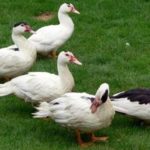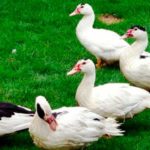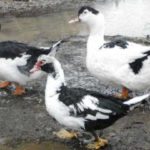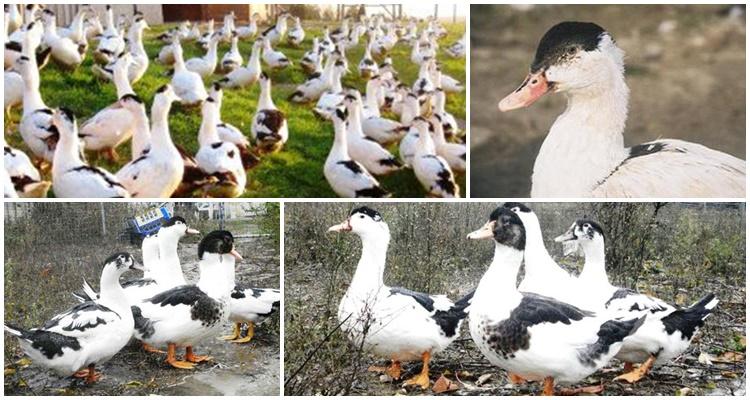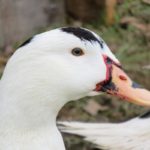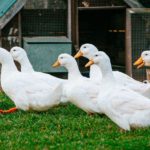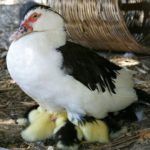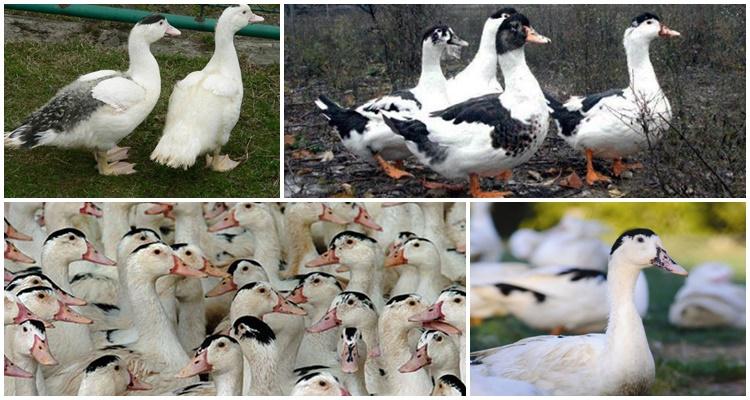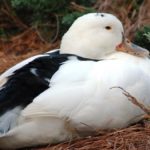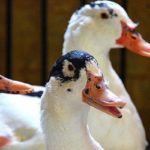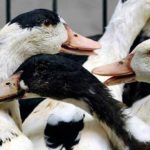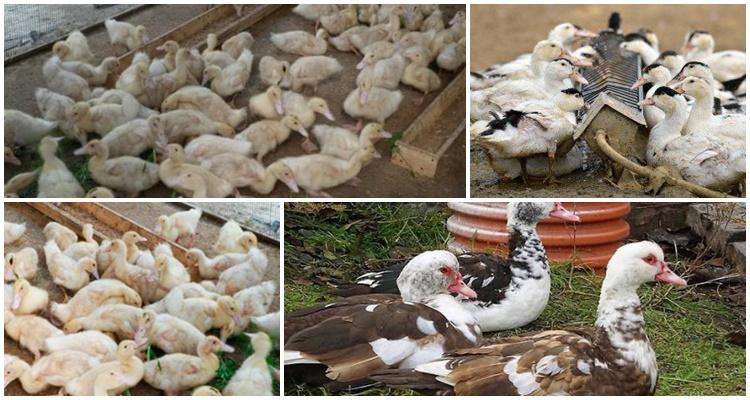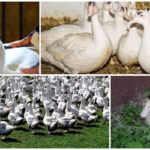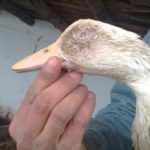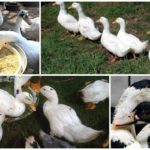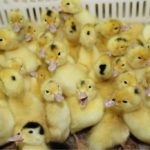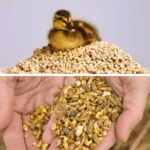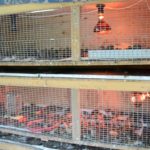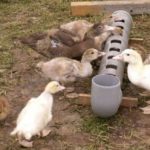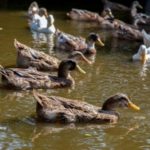The broiler breed was developed by French breeders in the mid-20th century and is characterized by accelerated maturation and excellent meat productivity. Hybrid ducks resulting from crossing musk drakes and Peking females are called mulards; raising them both at home and on large farms does not cause difficulties. Ducks quickly gain weight, produce dietary meat with excellent taste, and behave calmly and uncapriciously.
Positive and negative sides
Is it possible to breed Mulard ducks at home?
Breeding at home is possible. To get broiler chicks, Muscovy and Pekin ducks are needed. If you don’t have time for independent selection, you can buy ducklings from breeders. But the sold mulards often turn out to be weak and die.
To buy healthy chicks that are likely to survive, you need to pay attention to their appearance and behavior.
Healthy Mulard ducklings are active, fussy, their wings fit tightly to the body, and the anal area is clean.
Building a shed for a hybrid
The poultry house in which the mulards will live must be dry, illuminated, ventilated, but without drafts. You can adapt an existing barn into a poultry house; to do this, you need to fill in the cracks and eliminate dampness and mold.
If you don't have a barn, you'll have to build a bird house from scratch. The building is made of wood.The floor should be 40-50 cm from the soil surface, it is thinly coated with slaked lime, and straw is laid on top. The entrance with a door and a lift is made on the south side. The roof should be sloped to prevent rain moisture from getting inside. It is advisable to provide natural lighting, with Mulard ducks They grow more actively, but artificial ones can be made.
Rules for caring for ducks
The temperature inside the poultry house should be 16-18 °C, humidity – 60-70%. The bedding should be thick; straw or sunflower husks will do. Sawdust should not be used: it absorbs moisture. While the mulards of one brood are growing, the litter is periodically added. After slaughter, the poultry house is disinfected and the floor is re-lime-covered.
Caring for French broilers is easy. Feeders are made of wood, plastic or galvanized iron. Ducks eat sloppily and scatter food, so feed is poured into a third of the container. The drinking bowls are installed small, otherwise the ducks will try to climb into them.
If mulards are intended to produce not only meat, but also down, then, in the absence of a natural body of water, a basin of water should be placed in the pen where the ducks can swim. At 1 m2 The poultry house should have no more than 3 individuals, and 1 individual for the same pen space. It is unacceptable for Mulards to be kept with birds of other species and breeds.
Feeding and fattening
Broilers are fed with compound feed, dividing the diet into starter (the first 10 days of life), stimulating (10-25 days) and finishing (from 25 days before slaughter). In the absence of feed, you can feed the birds:
- corn (60%);
- oats (20%);
- barley (10%);
- meal, cake (5%);
- bone meal, premixes, chalk, salt (5%).
The grain is given crushed, dry or in a wet mash with the addition of boiled potatoes, bran, vegetables, silage, seaweed, and fish. Fill the mash with water, whey, and meat broth. For better digestion, ducks should eat coarse sand in small quantities.
Mulard ducks feed according to this scheme:
- from the first days of life to 2 weeks of age - 7-8 times;
- up to 4 weeks – 4-6 times;
- up to 3 months – 3 times.
Breeding for Beginners
To breed broilers, choose one drake and 4 females of 6-10 months of age. Hatchery breeding is not required; hens hatch eggs well. The right time for bird breeding is from early May to mid-June.
You cannot keep a drake selected for crossing with representatives of his breed, otherwise he will not want to cover females of another breed offered to him. As a result, the ducklings that will appear are not mullard ducklings, but Muscovy or Peking ducklings. At first, Mulard drakes usually ignore females of another breed, but gradually they get used to it and get down to business.
If the musk drake stubbornly ignores the Beijing females, then you can cheat: paint their backs with dark dye.
Ducks lay in comfortable nests with straw bedding. To raise ducklings, nests are built in a calm and secluded place. A feeder and a drinking bowl are attached next to the nest, and a bowl of water is placed for swimming.Egg collection begins 2 weeks after the birds join and is collected within a week. About 15 eggs are laid in the nest. The hen should be an Indian duck. Mulard ducklings appear a month later. The first week of life is the most difficult in raising offspring. Mulard ducklings survive and grow quickly in high temperatures and intense light.
Raising young animals
On the first day, the ducklings are given a weak manganese solution. On the second day, boiled yolk is given, it is crumbled onto the backs of the chicks, since at first they only grab moving food. If this measure does not help, then you will have to put food in the duckling’s mouth.
In the first 20 days, mulard ducklings should be under infrared light at a distance of 50 cm. Next, a 60 W lamp per 3 m of space is turned on in the poultry house. Bye Mulard ducks Before reaching 2 months of age, they must be kept under 24-hour light. They begin walking the chicks when they are 3 days old, if the outside air temperature is not lower than +18 °C. The table shows what the temperature should be for young mulards to grow without loss.
| Age of ducklings, days | Temperature in the poultry house, °C | Temperature under the lamp, °C |
| until 3 | 23-25 | 38-40 |
| 3-7 | 22-23 | 30-32 |
| 8-15 | 20-22 | 27-30 |
| 16-21 | 18-20 | 23-25 |
| 22-30 | 16-18 | 20-22 |
When preparing the diet, the growth period of the birds is taken into account. For the first week, mulard ducklings eat crushed grain with boiled yolk. Next, the yolk is replaced with boiled potatoes. At 2 weeks, mulards begin to eat crushed algae, which helps strengthen the immune system, bran and bone meal to strengthen the skeleton. Boiled carrots and grated fodder beets are added to the diet. Sources of minerals are placed in a separate bowl - shell rock, chalk, crushed eggshells. For food additives, it is advisable to use low-fat cottage cheese and yeast (1 g per individual).
The water in the drinking bowl is changed regularly.Ducklings often have clogged sinuses, so water is necessary not only for drinking, but also for rinsing the nose.
Possible diseases and vaccination against them
Mulard ducks not susceptible to most infectious diseases. But there are pathologies that can occur in hybrid broilers:
- Polymorphosis is a parasitic disease caused by an intestinal worm. Accompanied by exhaustion and diarrhea. For treatment, Dichlorophene is used, administered once into the feed (0.5 mg per 1 kg). To prevent illness, birds are given 0.1% copper sulfate to drink twice a week.
- Aspergillosis is a fungal pathology that occurs when feed and bedding become moldy. Manifested by lethargy, vomiting, difficulty breathing, paralysis of the paws. To remove the fungus, use the drug "Nystatin".
- Viral hepatitis. Mulard ducks need vaccination when the farm is located in a region with an unfavorable epidemic situation. Dry VGNKI vaccine (0.5 ml per individual) is injected intramuscularly into the duck's thigh.
- Cloacitis is inflammation and ulceration of the mucous wall of the cloaca caused by vitamin deficiency. For treatment, vitamin complexes are included in the diet. Ulcers and cracks on the anus of the duck are lubricated first with iodine, then with zinc ointment.
- Cannibalism. Mulard ducks attack each other, peck until they bleed, and pluck feathers either when they are kept in close, crowded conditions, or when there is a lack of protein in the diet. In the first case, the space of the poultry house is expanded, in the second, legumes, skim milk, and meat flour are added to the diet.
- Baldness is a symptom of hypovitaminosis and mineral deficiency. Ducks should eat more food rich in vitamins A and D.
When can you cut?
Mulard ducks become suitable for slaughter at 3-4 months. Feeding longer becomes unprofitable, as the birds' growth slows down.Some farmers slaughter 2.5-month-old ducklings; by this age, the ducklings already weigh 3-4 kg. Birds should not be left for the winter. Mulard ducks in the cold they will eat more than they should, which will further reduce profitability.

